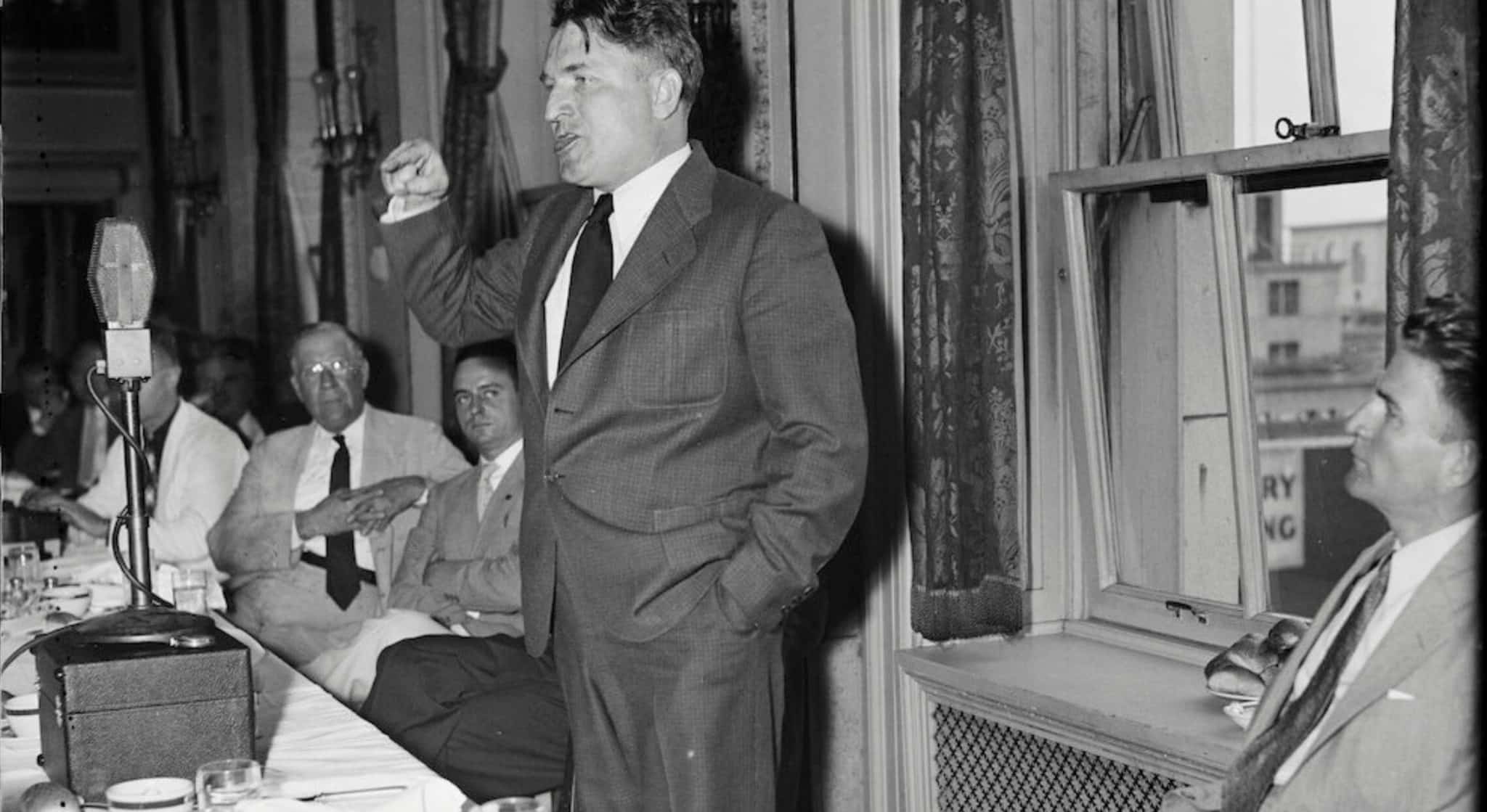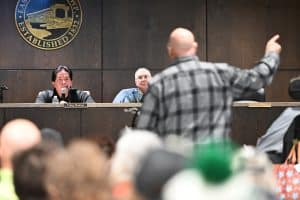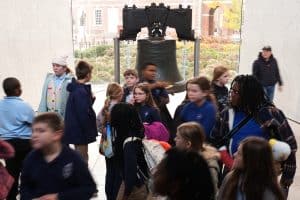“Let me tell you, my friends, that if it is rabble-rousing to praise the flag and the Constitution and to love and revere the Holy Bible, then I pray to God that He in His wisdom will make me the greatest rabble-rouser in the land.” – Gerald L.K. Smith, 1936
Christian Nationalism is once again on the rise. Members of Congress have professed its creed, including Republicans Marjorie Taylor Greene of Georgia, Lauren Boebert of Colorado, and Mary Miller of Illinois. So has white nationalist, Holocaust denier, and Trump-dinner-guest Nick Fuentes. Current Speaker of the House Mike Johnson is animated by Christian Nationalist ideas.
But what exactly is Christian Nationalism? To answer this question, it helps to examine one of its early ideologues, Gerald L.K. Smith, one of the most hateful demagogues to ever stalk the United States.
Smith, a man once cited by Baltimore journalist H.L. Mencken as “the gutsiest and goriest, loudest and lustiest, the deadliest and damndest orator ever heard on this or any other earth,” has largely flown under the historical radar. While his fellow rabble-rouser (and occasional rival) Father Charles E. Coughlin, the “Radio Priest,” has been the subject of several biographies, there is only one about Smith: Gerald L.K. Smith: Minister of Hate by Glen Jeansonne (two, if you count Smith’s own self-published and self-serving Besieged Patriot: Autobiographical Episodes Exposing Communism, Traitorism, and Zionism From the Life of Gerald L.K. Smith). Given the revival of his ideas and this movement, Smith’s life and legacy underline Christian Nationalism’s reliance on demagoguery.
Smith was born in southwest Wisconsin on February 27, 1898. His family were devout members of the Disciples of Christ and his father was a staunch supporter of progressive governor and Senator Robert M. “Fighting Bob” La Follette. Smith was a renowned speaker as a student, winning an award for reciting populist presidential candidate William Jennings Bryan’s “Cross of Gold” speech. This ability to captivate an audience followed him throughout his life. By the age of nineteen, he was ordained as a minister in the Disciples.
Early in his career, Smith broke from his family’s progressivism. He was alleged to be a member of the Ku Klux Klan when he was a minister in Indiana (a Klan stronghold in the 1920s). In 1933, he wrote to a returning visitor from Germany, “I am anxious to get in touch with his Honor, Adolf Hitler, but knowing that you are recently removed from Germany, before doing so I desire your opinion of conditions in the country. They look good to me.”
William Dudley Pelley’s fascist Silver Shirts were a temporary home for Smith after he left his Shreveport, Louisiana, parish. He gave lectures for the group with titles like “Some Day 100 Million Americans Will Hide Behind the Silver Shirt for Protection.” But Pelly’s outfit was small fry compared to Smith’s next ally, “Kingfish” Huey Long.
Smith became organizer for the Louisiana demagogue’s Share Our Wealth Society, a movement to confiscate large fortunes, inheritances, and incomes, and redistribute them to poor families. Smith traveled the country speaking on behalf of Long’s program and organizing new branches of the Society. But after Senator Long’s murder, Smith found himself without political allies in Louisiana. He briefly joined Georgia Governor Eugene Talmadge, a white supremacist who claimed Mein Kampf as his favorite book, but the alliance soon crumbled.
In 1936, Smith joined with Father Coughlin and pension advocate Frances Townsend to launch the Union Party. Their presidential candidate was Congressman William Lemke. Smith was very close to Townsend at this point, giving a well-received speech at the Townsend convention that went beyond demagoguery to sheer nonsense. Smith bellowed, “You give me Santa Claus and the Bible and the Constitution and the Flag and the Townsend Plan, and I will do ten thousand times as much as you will with the Russian primer, no Santa Claus, and the Lenin communistic Marx plan.” While the Townsendites ate it up, not everyone was convinced. In a March of Time newsreel, the narrator warned ominously of “the Lunatic Fringe,” and Smith’s similarity to Mussolini and Hitler.
As it became clear that Lemke had no chance of unseating incumbent President Franklin D. Roosevelt in the election, Smith began constructing a new nationalist organization, the Committee of One Million. The Committee and Smith soon declared that the most important nationalist goal was union-busting. Smith toured the country denouncing the progressive labor organization, the CIO, and helping to break strikes. He inherited Coughlin’s radio network after the priest was silenced, and continued Coughlin’s crusades against unions, Roosevelt, and internationalists.
LISTEN: The Christian Right’s Crusade for Power and War on Democracy, with Katherine Stewart
When he moved his operations to Detroit in 1939, Smith was assisted by contributions from various businessmen like Henry Ford, Ransom E. Olds, and Horace Dodge. Smith claimed that it was Ford who introduced him to antisemitism through the tycoon’s pamphlet, The International Jew. Smith made friends in Congress as well, including nativists Clare E. Hoffman and Robert Rice Reynolds. Reynolds wanted to build a wall around the country to keep out immigrants—sound familiar?—and both were sympathetic to fascism. Hoffman reassured Americans: “Many of us doubt that Germany wants more than has been asked through the ages by every people, by every nation, which has found itself with territory too small.” Reynolds claimed “Hitler and Mussolini have a date with destiny. It’s foolish to oppose them, so why not play ball with them?”
In 1942, Smith ran for Michigan’s Senate seat as a Republican. He was the subject of a profile in The Nation as part of the magazine’s “Keep Them Out!” series warning of “anti-democratic” Congressional candidates. Smith opposed war-time rationing and non-defense spending. He supported the creation of a “Christian America” and one of his slogans was “Christ First in America.” Initially, Smith was the sole candidate on the Republican side. Republican party bosses feared defeat with an extremist like Smith on the ticket, so they recruited the moderate judge Homer Ferguson to challenge him. Smith’s run ended in failure, with Ferguson winning the primary by nearly 2 to 1. Still, more than 100,000 Michiganders voted for Smith.
The same year as his Senate run, Smith debuted his publication The Cross and the Flag. The new magazine was lauded by Senator Reynolds who said “It speaks the truth.” In 1943, Smith launched the America First Party, an obvious attempt to recapture the success of the isolationist America First Committee, whose platform called for fighting communism, deporting immigrants to create jobs, raising tariffs, ending all immigration, and protecting the interests of white Americans. In 1944, members of the party endorsed sterilizing and deporting all Jews. After World War II, the Party was re-christened as the Christian Nationalist Crusade.
During the 1940s, Smith became openly racist and antisemitic. He spread conspiracy theories that Presidents Roosevelt and Truman were secretly Jews. He fumed against racial “mongrelization.” Despite this rhetoric, he continued to have some influence in the nation’s Capital. His petition urging an investigation of Hollywood’s purported Communism was brandished by House Un-American Activities Committee (HUAC) member and fellow bigot Congressman John Rankin. When Rankin questioned Smith before HUAC, he lobbed softball questions as Smith made antisemitic assertions like: “95 percent of the founders of the Russian government were apostate Jews” and “Newspapers cannot be free as long as they are dependent on department store advertising and 75 percent of the department executives are Jews.”
Smith attempted to build up a Christian Nationalist following after World War II and found his efforts resisted by socialists, trade unions, veterans groups, and civil rights organizations. When Smith held a rally in Minneapolis, Minnesota, he was picketed by the Socialist Workers Party and the American Veterans Committee who carried signs like “We Fought Hitler Over There! We Don’t Want A Hitler Over Here!” Similar pickets appeared in Detroit, Michigan, and Los Angeles, California. The Workers Party put out a pamphlet by Hal Draper labeling Smith “America’s No. 1 Fascist.” These activists stopped Smith’s momentum and he retreated to the fringes of American life.
Aside from Smith’s ideology, his greatest legacy is the Christ of the Ozarks statue that he constructed in Eureka Springs, Arkansas. The statue sits atop Magnetic Mountain, and can still be seen for miles around by viewers probably unaware of its originator’s politics. The statue has a dual purpose—it’s also the site of the graves of both Smith and his wife, Elna Smith.
Smith died in 1976 without ever becoming an American führer. Unfortunately, his ideas still have influence today. Although Smith’s more overt bigotry is out of fashion, other planks of his crusade still have cachet among today’s Christian Nationalists. These include identifying the United States as a country for Christians only, anti-communism, opposition to the income tax, nativism, and more. These ideas and rhetorical strategies are now being spread by politicians like Marjorie Taylor Greene, even if she probably doesn’t know the name Gerald K. Smith.
This article was originally published in The Progressive and reprinted here with permission.






